Study on the Compatibility between Combined Control of Channel Plugging and Foam Flooding and Heterogeneous Reservoirs—Taking Bohai Z Oilfield as an Example
Abstract
:1. Introduction
2. Materials and Methods
2.1. Experimental Materials
2.2. Experimental Equipment
2.3. Experimental Methods
2.3.1. Performance Evaluation
2.3.2. Experimental Procedures
- (1)
- Using intra-layer and inter-layer heterogeneous core samples, they were vacuumed and saturated with the formation water, their pore volume was measured, and the porosity was calculated.
- (2)
- As the core samples were saturated with the oil, the oil saturation was obtained, and after they were aged for 24 h, water flooding was conducted at the flow rate of 0.3 mL/min until the water cut of outlet liquid was 90%.
- (3)
- With a 0.2 PV channel plugging system injected at a flow rate of 0.2 mL/min, the injection pressure, liquid output, and water output were recorded after 24 h.
- (4)
- After 0.3 PV of the foam system was injected at a gas-liquid ratio of 1:1 and 1 mL/min of flow rate, 0.3 PV of the active water system, and 0.3 PV of foam system at a gas-liquid ratio of 1:1 at a flow rate of 1 mL/min were injected successively, and subsequent water flooding was carried out until the water content from the outlet end reached 98%, then the water flooding finished.
- (5)
- Using intra-layer and inter-layer heterogeneous core samples with different permeability combinations, steps 1 to 6 were repeated.
- (6)
- Oil and water production were recorded, and the effect of recovery improvement was evaluated.
3. Results
3.1. Preferred for Plugging System
- (1)
- The concentration of the main agent and the crosslinkers optimization
- (2)
- Initiator concentration optimization
3.2. Preferred for Foam Systems
- (1)
- Optimization of foaming agent concentration
- (2)
- Preferred foam stabilizer
3.3. Adaptability of Foam to Reservoir Permeability
- (1)
- Matching of foam systems in porous media
- (2)
- Dynamic characteristics of foam system in pore media
3.4. Foam Stability Research
3.5. Adaptability of Combined Profile Control to Reservoir Permeability
3.5.1. Intra-Layer Heterogeneity
3.5.2. Inter-Layer Heterogeneity
4. Conclusions
- The ability of the pre-channeling plugging system’s adaptability to the reservoir directly affects the performance of the subsequent foam, which is of great significance. Therefore, it is necessary to completely seal the high permeability layer. When the permeability grade difference is equal to 10, the maximum increase in the degree of recovery is obtained. As the grade difference increases or decreases, the recovery rate will also show a decreasing trend.
- The self-adaptability between bubble diameter and core pore diameter can spontaneously match with the reservoir, making up for the problem of poor matching of traditional plugging agents. With attention to the selection of bubble stabilizer and frother, the bubble volume and half-life reflect the degree of difficulty/ease and stability, both of which affect whether the bubble can play the role of deep transport in the reservoir.
- For intra-layer and inter-layer heterogeneous reservoirs, the overall pressure shows a fluctuating rising pattern has developed. The foam transport process is influenced by pressure gradient and porous medium shear, which can instantly change the microscopic force of a porous medium and is conducive to starting crude oil. Therefore, the combination of multi-segment plug gel and foam is more effective and can effectively improve the development effect of medium and low permeability layers.
Author Contributions
Funding
Institutional Review Board Statement
Informed Consent Statement
Data Availability Statement
Conflicts of Interest
References
- Zheng, X.; Shi, F.; Cao, G.; Yang, N.; Cui, M.; Jia, D.; Liu, H. Progress and prospects of oil and gas production engineering technology in China. Petrol. Explor. Dev. 2022, 49, 565–576. [Google Scholar] [CrossRef]
- Li, C.; Wang, F.; Du, Q.; You, C.; Shan, G.; Li, B.; Zhu, S. Water displacement rules of sandstone reservoirs at extra-high water-cut stage. Petrol. Geol. Dev. Daqing 2021, 33, 163–171. [Google Scholar] [CrossRef]
- Nie, C. The influence of oil layer heterogeneity on the development effect of ASP flooding and its countermeasures: Taking the second-class oil layer of Daqing Oilfield as an example. Petrol. Geol. Oilfield Dev. Daqing 2022, 41, 110–114. [Google Scholar] [CrossRef]
- Pu, W.; Mei, Z.; Xin, J. Experimental study on W/O surfactant control and flooding in late high water-cut heterogeneous reservoirs. Sci. Technol. Eng. 2021, 21, 3090–3096. [Google Scholar]
- Wang, S.; Wu, X.; Han, G.; Zhang, S.; Ren, Z.; Jia, Y.; Yang, J. Experimental simulation of seepage law and flow field characterization in ultra-high water cut period of high permeability reservoirs. Sci. Technol. Eng. 2019, 19, 141–148. [Google Scholar]
- Su, H.; Zhou, F.; Liu, Y.; Gao, Y.; Cheng, B.; Dong, R.; Liang, T.; Li, J. Microscopic occurrence characteristics of emulsion in porous media and its control and displacement mechanism. Petrol. Explor. Dev. 2021, 48, 1241–1249. [Google Scholar] [CrossRef]
- Lu, X.; Cao, B.; Xie, K.; Cao, W.; Liu, Y.; Zhang, Y.; Wang, X.; Zhang, J. Re-understanding of the enhanced oil recovery mechanism of polymer flooding in heterogeneous reservoirs. Petrol. Explor. Dev. 2021, 48, 148–155. [Google Scholar] [CrossRef]
- Wang, J.; Huang, W.; Zhao, Y.; Zhang, Y.; Wang, D.; Zhang, L. Research on the applicability of nitrogen foam control and flooding technology in block Y of Xinjiang Oilfield. Oil-field Chem. 2022, 39, 288–294. [Google Scholar] [CrossRef]
- Zheng, J.; Zhang, G.; Pei, H.; Shan, J.; Jiang, P.; Wu, H. Three-phase foam control and flooding system to improve steam flooding recovery. Oil-Field Chem. 2022, 39, 82–86+92. [Google Scholar] [CrossRef]
- Liu, D.; Cao, W.; Yang, K.; Shi, X.; Wei, X.; Zhang, T.; Sun, S. Properties of anionic surfactant/tertiary amine compound foam and CO2/N2 response performance. Oil-Field Chem. 2022, 39, 331–337. [Google Scholar] [CrossRef]
- Wang, Y.; Meng, L.; Li, Q.; Liang, L.; Lan, J.; Jiang, B.; Xu, N. Preparation and properties of ternary composite CO2-enhanced foam system. Appl. Chem. Ind. 2021, 50, 295–298+330. [Google Scholar] [CrossRef]
- Meng, X.; Ju, Y.; Wang, C.; Li, X.; Wang, N.; Zhou, Z. Optimization and design of new step-by-step plugging control technology—Taking Bohai BZ34-3 oilfield as an example. Petrol. Geol. Dev. Daqing 2021, 1–11. [Google Scholar] [CrossRef]
- Wang, H.; Wei, J.; Zhang, Z.; Shi, D.; Xu, L.; Chen, Z.; Xiao, W. Experimental study on combined recovery technique. Complex Hydrocarb. Reserv. 2021, 14, 80–84. [Google Scholar] [CrossRef]
- Shan, J.; Pei, H.; Zheng, W.; Xie, H.; Zheng, J.; Zhang, G. Heavy oil steam sealing/oil repellent combination regulating technology. Oil-Field Chem. 2022, 39, 87–92. [Google Scholar] [CrossRef]
- Liang, S.; Li, Q.; Lv, X.; Zhou, Y.; Cao, W.; Lu, X. Multi-level profile regulating drive technology effect and residual oil distribution. Petrol. Geol. Dev. Daqing 2018, 37, 108–115. [Google Scholar] [CrossRef]
- Zhang, X.; Zhang, T.; Jiang, P.; Ge, J.; Zhang, G. Study on the improvement of carbon dioxide foam stability by modified silica nanoparticles. Chem. J. Chin. Univ. 2020, 41, 1076–1082. [Google Scholar] [CrossRef]
- Li, J.; Liu, Y.; Gao, Y.; Cheng, B.; Meng, F.; Xu, H. Effects of microscopic pore structure heterogeneity on the distribution andmorphology of remaining oil. Petrol. Explor. Dev. 2018, 45, 1043–1052. [Google Scholar] [CrossRef]
- Gao, J.; Zhang, N.; Wang, L.; Lu, X.; Xue, B.; Li, Y.; He, X. Influence and mechanism of profile control and flooding agent injection pressure on split rate. Oil-Field Chem. 2021, 38, 427–433. [Google Scholar] [CrossRef]
- Lu, X.; Gao, J.; He, X.; Wei, W.; Su, Y.; Pei, X. Experimental study on the internal channeling law of heterogeneous reservoirs in layers: Taking Daqing Lamadian Oilfield as an example. Petrol. Geol. Recovery Effic. 2022, 29, 1–8. [Google Scholar]
- Liu, Y.; Wang, J.; Yang, Z.; Hu, Z.; Lu, Y. Visualization experiment on the mechanism of residual oil activated by CO2 foam in heavy oil reservoirs. Oil-Field Chem. 2021, 38, 80–84. [Google Scholar] [CrossRef]
- Gu, Y.; Cai, S.; Li, D.; Zhang, L.; Sun, H.; Yang, Y.; Zhu, G.; Xu, Z.; Bao, B. Influence of porous media heterogeneity on water-oil immiscible flooding and mechanism analysis. Sci. Sin. 2022, 52, 807–818. [Google Scholar] [CrossRef]
- Zhang, Y.; Lu, X.; Wang, T.; Liu, Y.; Xia, H.; Chen, Y.; Pan, H.; Liu, J. Study on technology of multi-stage plugging and profile control for advantage channels in Bohai Oilfield. Petrol. Geol. Recovery Effic. 2018, 25, 82–88. [Google Scholar] [CrossRef]
- Zhao, F.; Yi, Z.; Lv, H.; Yao, F.; Yang, J.; Li, J. Performance evaluation and oil displacement mechanism of surface active polymers. Petrochemical 2021, 50, 1310–1316. [Google Scholar] [CrossRef]
- Cai, H.; Guo, S.; Cheng, L.; Zhang, Z.; Jia, P. Laboratory experimental study on interlayer interference of multi-layer commingled production in Bohai thin oil oilfield. Geol. J. China Univ. 2021, 27, 587–592. [Google Scholar] [CrossRef]
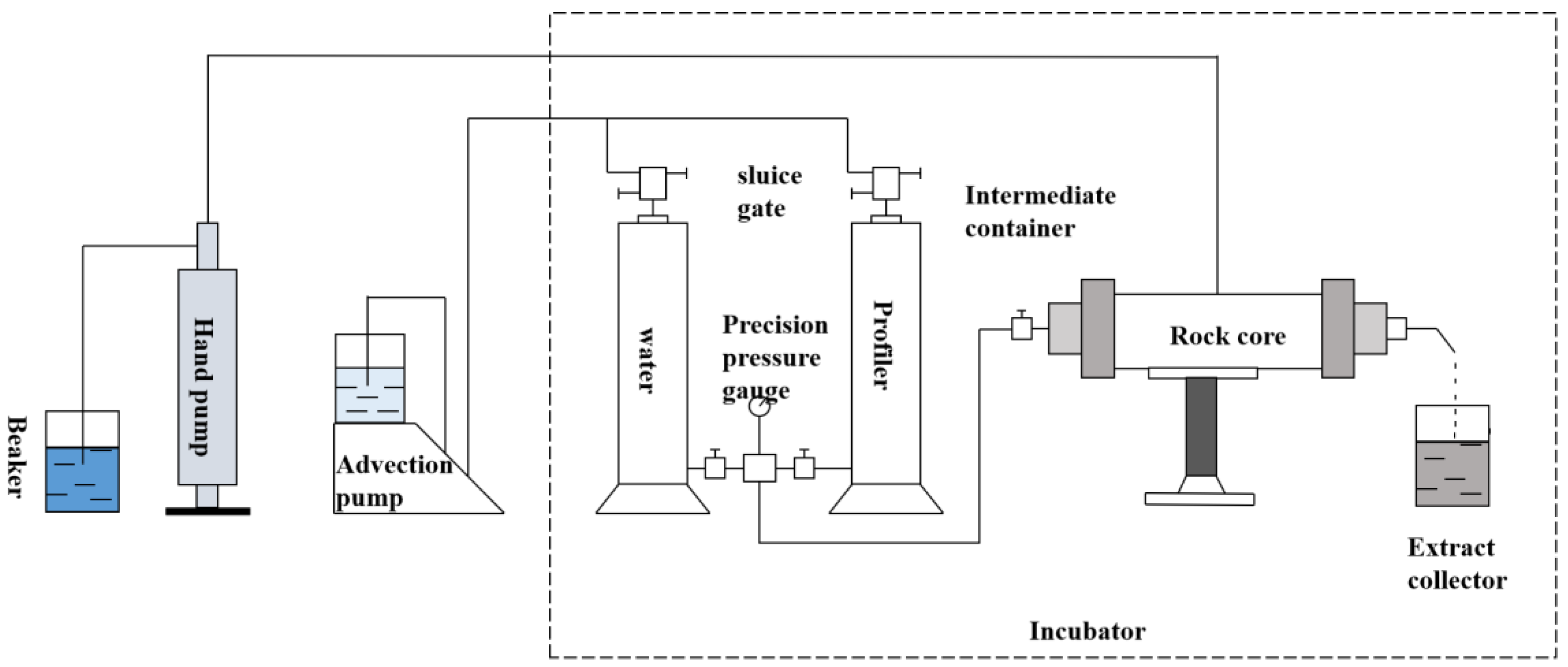
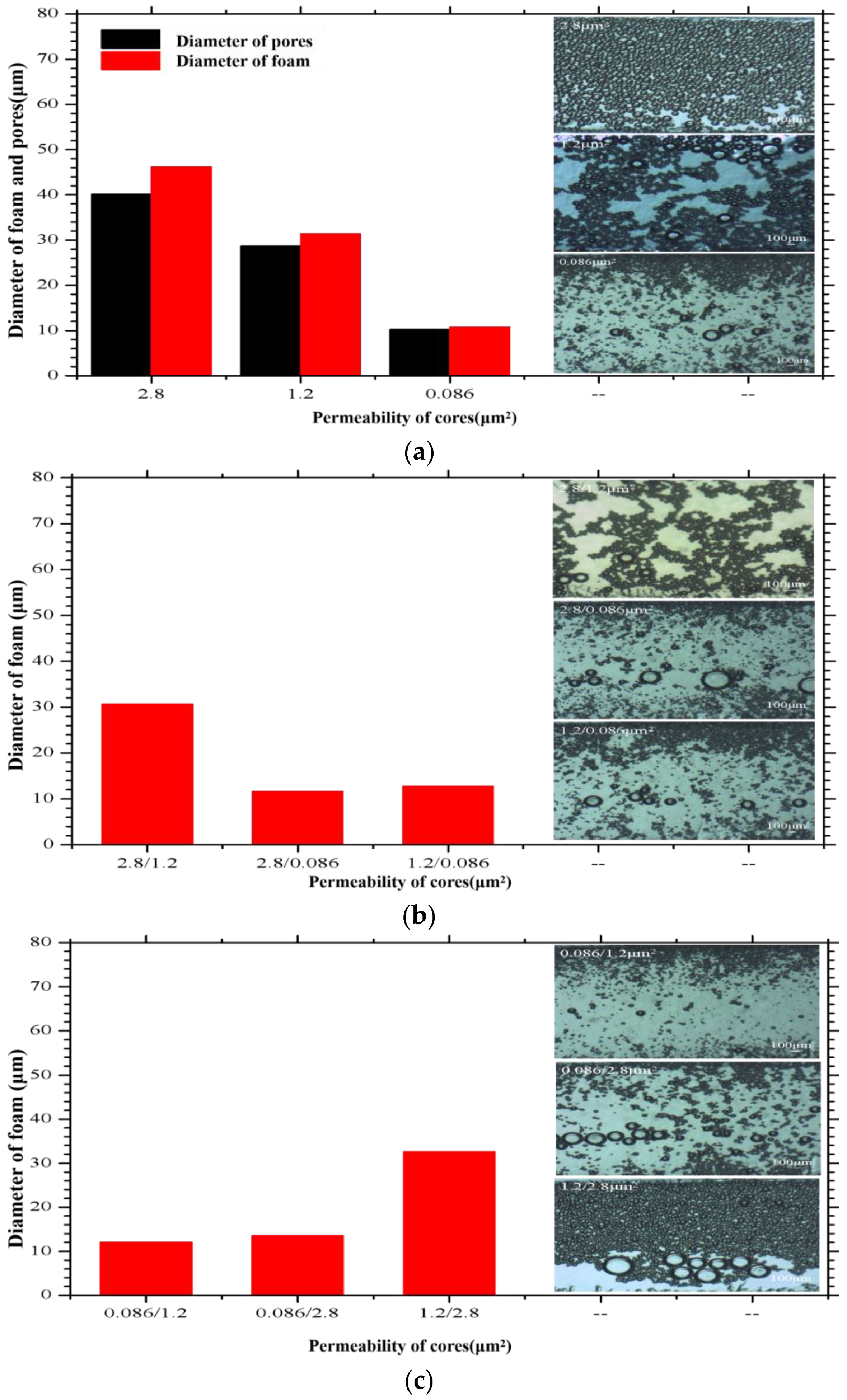

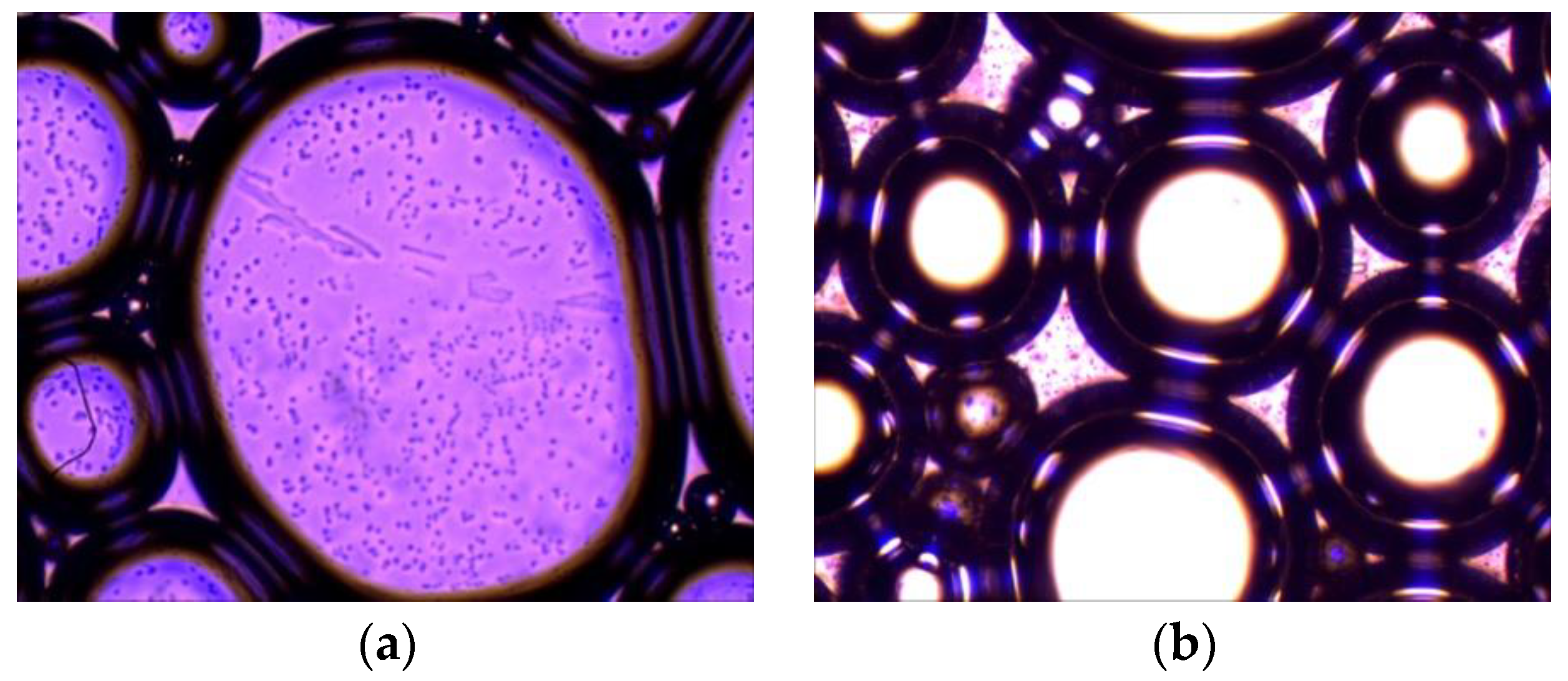
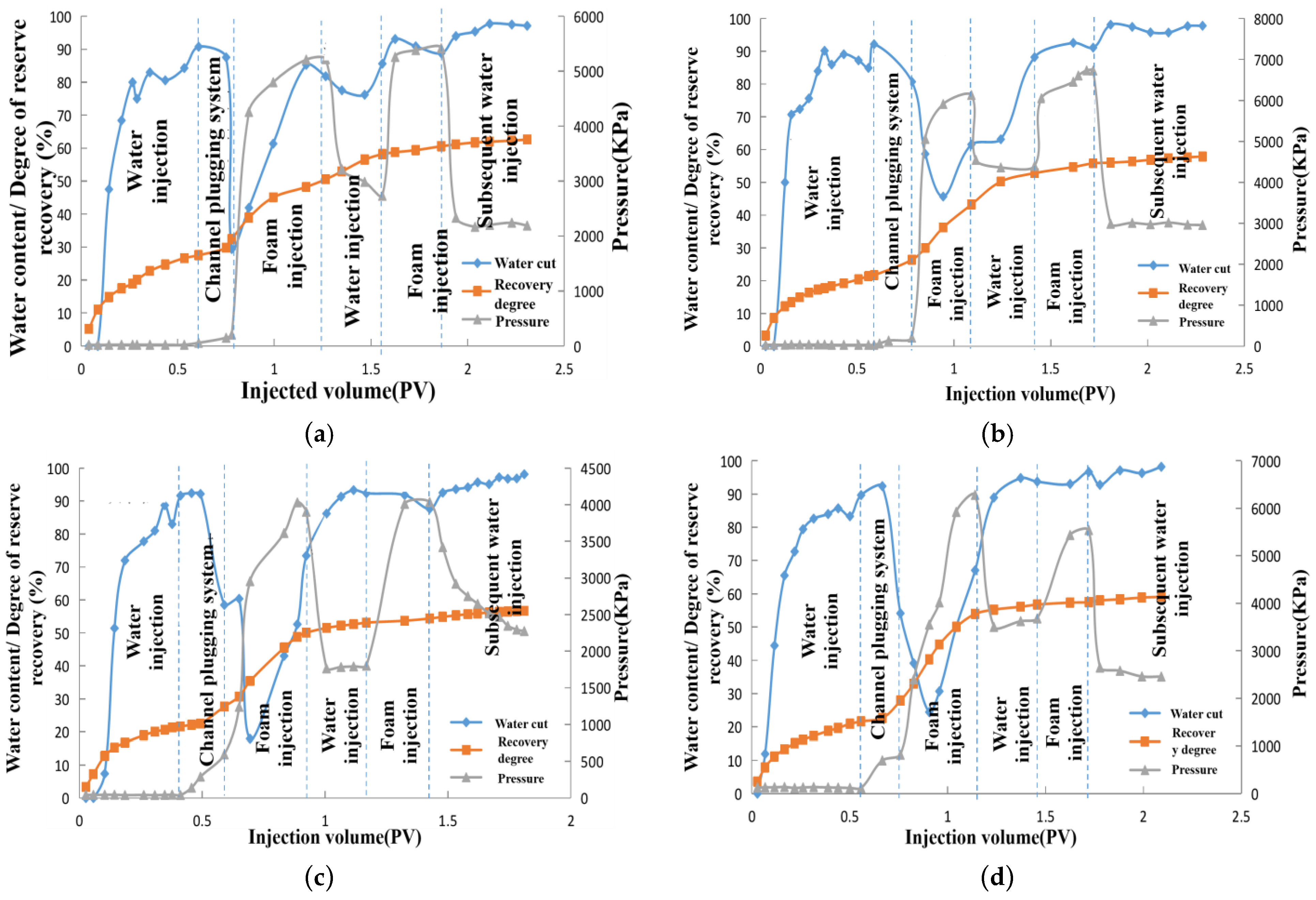
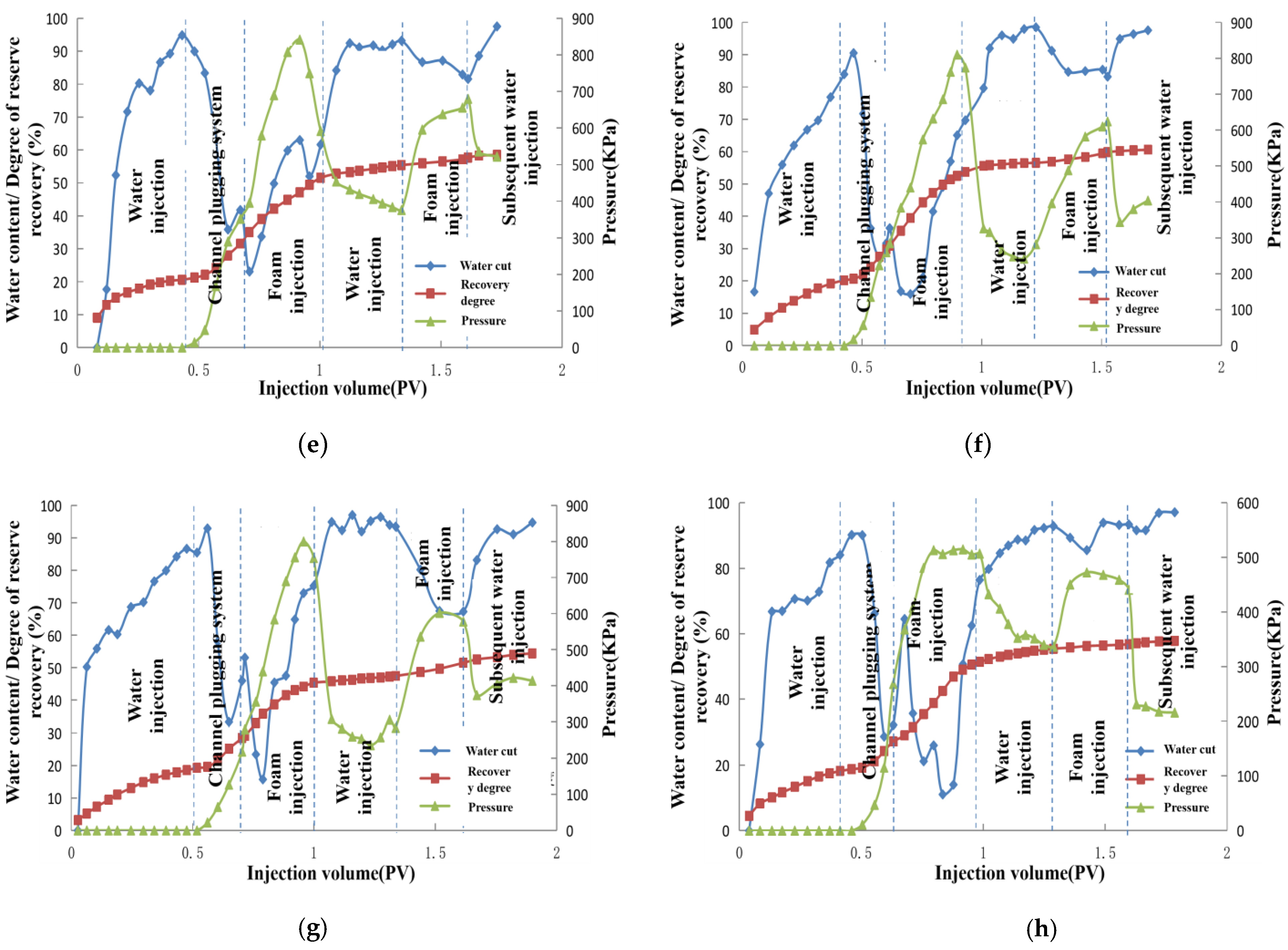
| Ion Composition and Content (mg/L) | Total Salinity (mg/L) | ||||||
|---|---|---|---|---|---|---|---|
| K+Na+ | Ca2+ | Mg2+ | Cl− | SO42− | CO32− | HCO3− | |
| 2735.03 | 192.58 | 29.61 | 4624.52 | 30.2 | 0.0 | 445.88 | 8057.82 |
| Main Agent A (%) | Main Agent B (%) | Crosslinking Agent (%) | Average Energy Storage Modulus (Pa) | Average Loss Modulus (Pa) | Viscosity before Gelation (mPa·s) | Viscosity after Gelation (mPa·s) |
|---|---|---|---|---|---|---|
| 3 | 3 | 0.005 | 53.8 | 9.6 | 14.5 | 25,800 |
| 3.5 | 3.5 | 102.9 | 18.8 | 19.6 | 43,753 | |
| 4 | 4 | 167.3 | 17.0 | 28.3 | 50,140 | |
| 3 | 3 | 0.01 | 102.9 | 18.8 | 15.4 | 39,080 |
| 3.5 | 3.5 | 149.2 | 13.3 | 22.4 | 46,973 | |
| 4 | 4 | 260.5 | 17.2 | 35.8 | 55,946 | |
| 3 | 3 | 0.015 | 213.8 | 19.7 | 19.5 | 43,426 |
| 3.5 | 3.5 | 236.8 | 22.5 | 26.7 | 47,566 | |
| 4 | 4 | 336.3 | 24.0 | 40.9 | 77,166 |
| Initiator (%) | Gel-Forming Time (h) | Average Storage Modulus (Pa) | Average Loss Modulus (Pa) | Viscosity after Gel Formation (mPa·s) |
|---|---|---|---|---|
| 0.005 | 7.5 | 462.5 | 39.1 | 108,500.0 |
| 0.01 | 5.5 | 458.1 | 41.8 | 103,520.0 |
| 0.015 | 4.5 | 416.3 | 36.6 | 101,460.0 |
| 0.02 | 3.0 | 405.6 | 36.7 | 102,293.3 |
| Foaming Agent Concentration (%) | Foaming Volume (mL) | Half-Life Period (min) | Comprehensive Value (mL·min) |
|---|---|---|---|
| 0.3 | 410 | 20 | 8200 |
| 0.4 | 430 | 25 | 10,750 |
| 0.5 | 440 | 27 | 11,880 |
| 0.6 | 430 | 26 | 11,180 |
| 0.7 | 415 | 25 | 10,375 |
| HPAM (%) | Foaming Volume (mL) | Half-Life Period (min) | Modified CMC Concentration (%) | Foaming Volume ((mL) | Half-Life Period (min) |
|---|---|---|---|---|---|
| 0 | 440 | 27 | 0 | 440 | 27 |
| 0.05 | 435 | 72 | 0.3 | 350 | 160 |
| 0.1 | 415 | 111 | 0.5 | 300 | 228 |
| 0.2 | 410 | 198 | 0.6 | 290 | 275 |
| 0.3 | 365 | 223 | 0.7 | 270 | 320 |
| Scheme | Permeability (×10–3 μm2) | Waterflooding Recovery Degree (%) | Increase in Recovery Degree of Compound Flooding (%) | The Lowest Point of Moisture Content Drop (%) | Final Recovery Degree (%) |
|---|---|---|---|---|---|
| a | 4000/2000/500 | 27.53 | 35.08 | 29.41 | 62.61 |
| b | 4000/2000/200 | 21.68 | 36.21 | 45.68 | 57.89 |
| c | 4000/2000/100 | 21.66 | 35.04 | 17.95 | 56.70 |
| d | 4000/1000/200 | 21.63 | 37.46 | 24.44 | 59.09 |
| Scheme | Core (×10–3 μm2) | Stage Cumulative Recovery Degree (%) (Each Sublayer) | Stage Recovery Degree Increase (%) (Each Sublayer) | Stage Cumulative Recovery Degree (%) (Overall) | Stage Recovery Degree Increase (%) (Overall) | ||||||
|---|---|---|---|---|---|---|---|---|---|---|---|
| Water Drive | Channel Plugging System | Foam Flooding | Channel Plugging System | Foam Flooding | Water Drive | Channel Plugging System | Foam Flooding | Channel Plugging System | Foam Flooding | ||
| e | 6000 | 45.56 | 69.09 | 71.93 | 23.53 | 2.84 | 20.61 | 31.58 | 58.53 | 10.97 | 26.95 |
| 2000 | 4.32 | 6.78 | 57.88 | 2.46 | 51.1 | ||||||
| 500 | 2.03 | 3.98 | 38.94 | 1.95 | 34.96 | ||||||
| f | 6000 | 45.30 | 70.66 | 72.65 | 25.36 | 1.99 | 20.22 | 30.91 | 60.60 | 10.69 | 29.69 |
| 2000 | 5.29 | 6.29 | 65.14 | 1.00 | 58.85 | ||||||
| 200 | 1.67 | 2.50 | 39.24 | 0.83 | 36.74 | ||||||
| g | 6000 | 46.59 | 72.35 | 74.08 | 25.76 | 1.73 | 19.23 | 29.07 | 54.43 | 9.84 | 25.36 |
| 2000 | 5.03 | 5.60 | 52.48 | 0.57 | 46.88 | ||||||
| 100 | 1.42 | 1.96 | 32.77 | 0.54 | 30.81 | ||||||
| h | 6000 | 46.17 | 73.09 | 74.86 | 26.92 | 1.77 | 18.75 | 29.05 | 57.84 | 10.30 | 28.79 |
| 1000 | 4.23 | 4.90 | 59.13 | 0.67 | 54.23 | ||||||
| 200 | 1.20 | 1.67 | 36.73 | 0.47 | 35.06 | ||||||
Publisher’s Note: MDPI stays neutral with regard to jurisdictional claims in published maps and institutional affiliations. |
© 2022 by the authors. Licensee MDPI, Basel, Switzerland. This article is an open access article distributed under the terms and conditions of the Creative Commons Attribution (CC BY) license (https://creativecommons.org/licenses/by/4.0/).
Share and Cite
Zhang, Y.; Wang, C.; Liu, M.; Zhou, Z.; Quan, J.; Zheng, X.; Zhan, Z. Study on the Compatibility between Combined Control of Channel Plugging and Foam Flooding and Heterogeneous Reservoirs—Taking Bohai Z Oilfield as an Example. Energies 2022, 15, 6203. https://doi.org/10.3390/en15176203
Zhang Y, Wang C, Liu M, Zhou Z, Quan J, Zheng X, Zhan Z. Study on the Compatibility between Combined Control of Channel Plugging and Foam Flooding and Heterogeneous Reservoirs—Taking Bohai Z Oilfield as an Example. Energies. 2022; 15(17):6203. https://doi.org/10.3390/en15176203
Chicago/Turabian StyleZhang, Yunbao, Chengzhou Wang, Ming Liu, Zhen Zhou, Jiamei Quan, Xulin Zheng, and Zhaohai Zhan. 2022. "Study on the Compatibility between Combined Control of Channel Plugging and Foam Flooding and Heterogeneous Reservoirs—Taking Bohai Z Oilfield as an Example" Energies 15, no. 17: 6203. https://doi.org/10.3390/en15176203
APA StyleZhang, Y., Wang, C., Liu, M., Zhou, Z., Quan, J., Zheng, X., & Zhan, Z. (2022). Study on the Compatibility between Combined Control of Channel Plugging and Foam Flooding and Heterogeneous Reservoirs—Taking Bohai Z Oilfield as an Example. Energies, 15(17), 6203. https://doi.org/10.3390/en15176203





